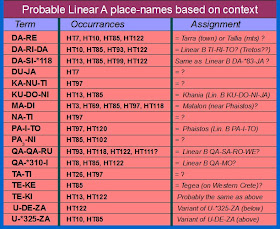After a lengthy absence, I have returned once again to share you some novel pieces of research. About four months ago, I started am ambitious project aimed at classifying most of the terms, especially names occurring in the Linear A corpus. My chief aim was to separate place-names from personal names and (at least approximately) annotate most of the words. But how could one determine the meaning of the Minoan terms by any certainty, given the small size (less than a thousand complete words) of the corpus?
Fortunately, the tablets themselves offer the key. The enduring scribal tradition, that also dictated the form of Linear B tablets, had born centuries earlier: despite being in a different language, and much more compressed, Linear A tablets were built around essentially the same principles as their late Linear B children. Most of the tablets record items - typically agricultural goods - collected as tax, marked by the name of their donors. But there are other topics as well: Just like in Linear B, certain Linear A tablets record the workforce at the disposal of the kingdom. These people-listing tablets come in three main varieties. Some of them list people by their place of origin, containing city-names as entries. Others list people by their gender, age or profession. And, last but not least, some Knossos Linear B tablets count people individually, by name.
It is relatively easy to pin-point toponyms in Linear B texts - even if the people mentioned have more than one qualifier - because of the very characteristic Greek adjectives in -JO or -JA or the dedicated allative (-DE) and locative cases. The numbers and other terms can also help to identify the listing principles: If the commodity is 'VIR' (men) and all numerals are '1', then the terms listed at each entry are most commonly personal names. If the tablet lists multiple 'VIR' per entry, then the terms are most commonly place-names. In some rare cases, there are higher than one 'VIR' quantities listed besides terms that describe professions, rather than places; in the latter case, terms are frequently ligatured or abbreviated.
Although Linear A tablets are much shorter, typically containing single-term entries in all contexts (on tablets dealing with taxes or payments as well as those assessing the workforce available), we can still use the above principles to identify their precise context. Most improtantly, we can identify a number of tablets with multiple 'VIR' entries, counting more than one human subject/term. It is utterly tempting to believe that at least some of these tablets deal with places of provenience. If we would be able to distinguish which ones, we would be able to draw a map of Minoan Crete!
My first table shows expressions that appear to be place-names, using the principle above. Interestingly, some of these terms also admit a nice interpretation as places, when compared with known Linear B toponyms. Examples include city names like PA-I-TO = Phaistos or KU-DO-NI = Kydonia / Khania (KU-DO-NI-JA in Lin B).
There is still one powerful tool to identify the meaning of entries on the Cretan clay tablets: this is overall context. Since most of the tablets are just simple lists, if we can ascertain the meaning of neighbouring entries, we can also have a good guess at those not yet identified. Thus if we identified some terms as place-names on a tablet dealing with taxes or workforce, there would be a very good chance, that the remaining, unidentified entries are also toponyms - and not personal names or profession-groups.
In my next collection, I listed the terms (names) that co-occur with those on Table #1. Unfortunately, I had to ommit many "absolute hapaxes" (single names with unique form, without any recognizable similarity to others), otherwise the table would have been too long. I also intentionally left out three further terms (KA-PA, KA-RU and A-KA-RU). These have the nasty tendency of frequntly occupying the initial position of tablet-headers, thus they are very likely transaction terms, not proper places. The remaining list still contains plenty of intriguing terms - many of them showing semi-regular variations (declensional forms?), that might be interpreted as case endings (locatives, elatives, allatives) or adjectives (ethnics).
One might have noticed, that most of my examples come from the Haghia Triada archive. That is because the fragmentary nature of most other archives does not enable us to conduct true contextual analyses. In absence of any other clue, we may still identify some toponyms, merely by comparing them to Linear B or Classic Era place-names known from Crete. On my last table, the the results of such a comparison are listed (only those terms are displayed, that have not been mentioned on previous lists).
Although the last list is the least reliable, it does feature most of the terms we would expect to be featured: the names of the holy mountains, and (although tentatively), names of many large townships. What is surprising, though, is the meager overlap between Linear A and Linear B terms, and the fact that most identifiable place-names on the Haghia Triada tablets refer to Western Cretan localties. We shall look into these matters to a much greater depth in the following posts!


